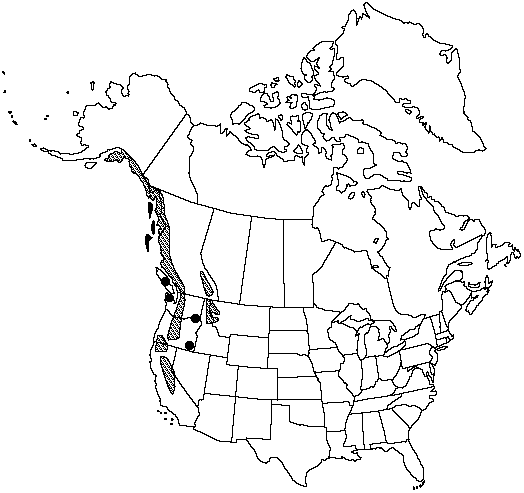Difference between revisions of "Tsuga mertensiana"
Traité Gén. Conif., ed. 2 250. 1867.
FNA>Volume Importer |
FNA>Volume Importer |
||
| Line 15: | Line 15: | ||
|name=Abies hookeriana | |name=Abies hookeriana | ||
|authority=A.Murray bis | |authority=A.Murray bis | ||
| − | }}{{Treatment/ID/Synonym | + | }} {{Treatment/ID/Synonym |
|name=Abies pattoniana | |name=Abies pattoniana | ||
|authority=A.Murray bis | |authority=A.Murray bis | ||
| − | }}{{Treatment/ID/Synonym | + | }} {{Treatment/ID/Synonym |
|name=Hesperopeuce mertensiana | |name=Hesperopeuce mertensiana | ||
|authority=(Bongard) Rydberg | |authority=(Bongard) Rydberg | ||
| − | }}{{Treatment/ID/Synonym | + | }} {{Treatment/ID/Synonym |
|name=Hesperopeuce pattoniana | |name=Hesperopeuce pattoniana | ||
|authority=(A.Murray bis) Lemmon | |authority=(A.Murray bis) Lemmon | ||
| − | }}{{Treatment/ID/Synonym | + | }} {{Treatment/ID/Synonym |
|name=Picea (tsuga) | |name=Picea (tsuga) | ||
|authority=hookeriana (A.Murray bis) Bertrand | |authority=hookeriana (A.Murray bis) Bertrand | ||
| − | }}{{Treatment/ID/Synonym | + | }} {{Treatment/ID/Synonym |
|name=Pinus hookeriana | |name=Pinus hookeriana | ||
|authority=(A.Murray bis) McNab | |authority=(A.Murray bis) McNab | ||
| − | }}{{Treatment/ID/Synonym | + | }} {{Treatment/ID/Synonym |
|name=Pinus pattoniana | |name=Pinus pattoniana | ||
|authority=(A.Murray bis) Parlatore | |authority=(A.Murray bis) Parlatore | ||
| − | }}{{Treatment/ID/Synonym | + | }} {{Treatment/ID/Synonym |
|name=Tsuga crassifolia | |name=Tsuga crassifolia | ||
|authority=Flous | |authority=Flous | ||
| − | }}{{Treatment/ID/Synonym | + | }} {{Treatment/ID/Synonym |
|name=Tsuga hookeriana | |name=Tsuga hookeriana | ||
|authority=(A.Murray bis) Carrière | |authority=(A.Murray bis) Carrière | ||
| − | }}{{Treatment/ID/Synonym | + | }} {{Treatment/ID/Synonym |
|name=Tsuga pattoniana var. hookeriana | |name=Tsuga pattoniana var. hookeriana | ||
|authority=(A.Murray bis) Lemmon | |authority=(A.Murray bis) Lemmon | ||
| − | }}{{Treatment/ID/Synonym | + | }} {{Treatment/ID/Synonym |
|name=Tsuga-picea hookeriana | |name=Tsuga-picea hookeriana | ||
|authority=unknown | |authority=unknown | ||
| Line 59: | Line 59: | ||
|elevation=0–2400m | |elevation=0–2400m | ||
|distribution=B.C.;Alaska;Calif.;Idaho;Mont.;Nev.;Oreg.;Wash. | |distribution=B.C.;Alaska;Calif.;Idaho;Mont.;Nev.;Oreg.;Wash. | ||
| − | |discussion=<p>The wood of Tsuga mertensiana is somewhat inferior to that of western hemlock both for building purposes and as pulp. This is a very handsome tree with its branches densely clothed with pale, spreading leaves and is adaptable to a wide variety of climatic conditions.</p><!-- | + | |discussion=<p>The wood of <i>Tsuga mertensiana</i> is somewhat inferior to that of western hemlock both for building purposes and as pulp. This is a very handsome tree with its branches densely clothed with pale, spreading leaves and is adaptable to a wide variety of climatic conditions.</p><!-- |
| − | --><p>M.Van Campo-Duplan and H.Gaussen (1948) postulated that this taxon originated by hybridization between Picea and Tsuga. Although this is unlikely, some characteristics such as leaf arrangement and shape, phenolic chemistry, and pollen grain structure lend some support for this hypothesis.</p> | + | --><p>M.Van Campo-Duplan and H.Gaussen (1948) postulated that this taxon originated by hybridization between <i>Picea</i> and <i>Tsuga</i>. Although this is unlikely, some characteristics such as leaf arrangement and shape, phenolic chemistry, and pollen grain structure lend some support for this hypothesis.</p> |
|tables= | |tables= | ||
|references= | |references= | ||
| Line 83: | Line 83: | ||
|publication year=1867 | |publication year=1867 | ||
|special status= | |special status= | ||
| − | |source xml=https://jpend@bitbucket.org/aafc-mbb/fna-data-curation.git/src/ | + | |source xml=https://jpend@bitbucket.org/aafc-mbb/fna-data-curation.git/src/8f726806613d60c220dc4493de13607dd3150896/coarse_grained_fna_xml/V2/V2_23.xml |
|genus=Tsuga | |genus=Tsuga | ||
|species=Tsuga mertensiana | |species=Tsuga mertensiana | ||
Revision as of 16:46, 18 September 2019
Trees to 40m; trunk to 1.5m diam.; crown conic. Bark charcoal gray to reddish brown, scaly and deeply fissured. Twigs yellow-brown, glabrous to densely pubescent. Buds oblong, 3–4mm. Leaves 10–25(–30)mm, mostly spreading in all directions from twigs, curved toward twig apex, thickened centrally along midline, somewhat rounded or 4-angled in cross section, both surfaces glaucous, with ±inconspicuous stomatal bands; margins entire. Seed cones oblong-cylindric, 3–6 × 1.5–3cm; scales broadly fan-shaped, 8–15 × 8–15mm, apex rounded to pointed. 2n =24.
Habitat: Coastal and montane forests to alpine slopes (where it occurs in krummholz form)
Elevation: 0–2400m
Distribution

B.C., Alaska, Calif., Idaho, Mont., Nev., Oreg., Wash.
Discussion
The wood of Tsuga mertensiana is somewhat inferior to that of western hemlock both for building purposes and as pulp. This is a very handsome tree with its branches densely clothed with pale, spreading leaves and is adaptable to a wide variety of climatic conditions.
M.Van Campo-Duplan and H.Gaussen (1948) postulated that this taxon originated by hybridization between Picea and Tsuga. Although this is unlikely, some characteristics such as leaf arrangement and shape, phenolic chemistry, and pollen grain structure lend some support for this hypothesis.
Selected References
None.